- Mozart: Four Horn Concertos and Horn
Quintet
- David Pyatt, horn
- Sir Neville Marriner
- Academy of St. Martin in the Fields
- Erato (Warner)
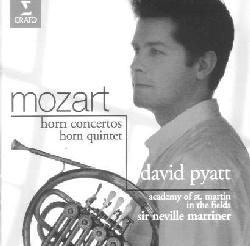 Young horn player David Pyatt was the
Gramophone Young Artist of the Year in 1996. Here with the very fine
ASMF orchestra, he offers Mozart’s familiar and lovable Concertos K.
412, K. 417, K. 447, K. 495 and the Horn Quintet K. 407. From the
very first bars, there is no doubt Pyatt is a performer of
sensitivity and distinction in the great English tradition. He
deploys a soft, warm tone without any hunting-horn brassiness. His
splendidly clear and steady sound is best appreciated in slow
lyrical passages. However, his intonation and execution falter just
a bit in fast, ascending runs and on high notes (the Rondo of K.417
and the Allegro of K. 447). Pyatt’s tuckets are not as neat as Barry
Tuckwell’s or Dennis Brain’s, and his interpretation is
conservative. Not for him the smutty Mozart-Leutgeb jokes that
enliven Karajan’s jocular, cantabile set with Dennis Brain (EMI). My
major complaint with this disc is technical: Pyatt’s horn is
recessed back into or behind the orchestra. I prefer the solo
instrument to stand front and center, as it does in the rawer,
crisper classic Dennis Brain recording. Pyatt’s new disc is a
keeper, but for repeated listening I prefer Tuckwell’s version with
the English Chamber Orchestra (London). Philip
Anson
Young horn player David Pyatt was the
Gramophone Young Artist of the Year in 1996. Here with the very fine
ASMF orchestra, he offers Mozart’s familiar and lovable Concertos K.
412, K. 417, K. 447, K. 495 and the Horn Quintet K. 407. From the
very first bars, there is no doubt Pyatt is a performer of
sensitivity and distinction in the great English tradition. He
deploys a soft, warm tone without any hunting-horn brassiness. His
splendidly clear and steady sound is best appreciated in slow
lyrical passages. However, his intonation and execution falter just
a bit in fast, ascending runs and on high notes (the Rondo of K.417
and the Allegro of K. 447). Pyatt’s tuckets are not as neat as Barry
Tuckwell’s or Dennis Brain’s, and his interpretation is
conservative. Not for him the smutty Mozart-Leutgeb jokes that
enliven Karajan’s jocular, cantabile set with Dennis Brain (EMI). My
major complaint with this disc is technical: Pyatt’s horn is
recessed back into or behind the orchestra. I prefer the solo
instrument to stand front and center, as it does in the rawer,
crisper classic Dennis Brain recording. Pyatt’s new disc is a
keeper, but for repeated listening I prefer Tuckwell’s version with
the English Chamber Orchestra (London). Philip
Anson
- Dance of the Angel
- Slava Grigoryan, guitar
- Sony SK63011
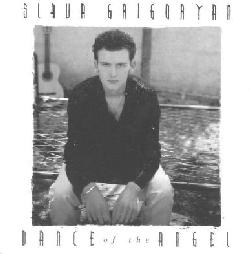 Slava Grigoryan’s first recording, "The
Spirit of Spain", was a best-seller in Australia, where the 21-year
old Khazakstan native now lives. His new album, "Dance of the
Angel", featuring Latin American guitar music, should be a big
success as well. This is a thoroughly laid back, relaxing recital by
an extremely sensitive guitarist with a great lyrical gift. The
program is balanced between Piazzolla’s Nuevo Tango ("tango more for
listening than for dancing") and catchy Bossa Nova dance rhythms.
The compositions are reflective, nostalgic, siesta tunes with a wee
bit of new age improvisation thrown in as a concession to the
Zeitgeist. Grigoryan draws charmingly balanced, subtle effects from
his Ignacio Fleta guitar and is accompanied on a few tracks by his
violinist-father Eduard. The recorded sound is clear and warm
without any reverb or fakery. This beautiful offering will appeal to
classical guitar lovers as well as to anyone seeking soothing but
intellectually respectable background music. Highly
recommended. P.A.
(Slava Grigoryan will play at Centre Pierre-Péladeau,
Thursday Oct. 16) Slava Grigoryan’s first recording, "The
Spirit of Spain", was a best-seller in Australia, where the 21-year
old Khazakstan native now lives. His new album, "Dance of the
Angel", featuring Latin American guitar music, should be a big
success as well. This is a thoroughly laid back, relaxing recital by
an extremely sensitive guitarist with a great lyrical gift. The
program is balanced between Piazzolla’s Nuevo Tango ("tango more for
listening than for dancing") and catchy Bossa Nova dance rhythms.
The compositions are reflective, nostalgic, siesta tunes with a wee
bit of new age improvisation thrown in as a concession to the
Zeitgeist. Grigoryan draws charmingly balanced, subtle effects from
his Ignacio Fleta guitar and is accompanied on a few tracks by his
violinist-father Eduard. The recorded sound is clear and warm
without any reverb or fakery. This beautiful offering will appeal to
classical guitar lovers as well as to anyone seeking soothing but
intellectually respectable background music. Highly
recommended. P.A.
(Slava Grigoryan will play at Centre Pierre-Péladeau,
Thursday Oct. 16)
- Angelika Kirchschlager: Mahler
and Korngold Lieder
- Helmut Deutsch, piano
- Sony SK68344
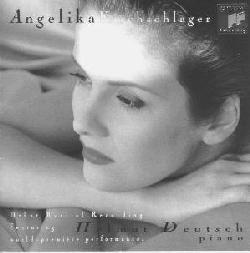 We must now add Austrian Angelika Kirchschlager to
the group of remarkable mezzo-sopranos which includes Cecilia
Bartoli, Jennfier Larmore, and Anne-Sophie von Otter. Judging from
this debut recital disc Kirchschlager has it all: sultry good looks,
abundant musicality, intelligence, sensitivity and, oh yes, an
exceptionally beautiful voice. Her unfamiliar but interesting
program includes the world premiere recording of Erich Korngold’s
Songs of the Clown, Op.29, a setting of Shakespeare texts that shows the
composer at his most melodically beguiling. Five songs by Alma Maria
Schindler-Mahler are perhaps a bit derivative but no less pleasing
to the ear. The rest of the disc is devoted to songs by Gustav
Mahler. Kirchschlager’s is a high mezzo in the style of Frederica
von Stade, naturally placed and with a ravishing middle. Throughout
the program Kirchschlager impresses us with unfailing beauty of
tone, genuine charm and individuality. Unlike many young singers
today, she is not afraid to interpret. Her only fault is her
tendency to occasional hardness at the highest notes. Helmut Deutsch
offers sensitive, sympathetic support and the recorded sound is
clear and spacious, if a bit reverberant. This disc makes one wish
for more from Kirchschlager soon. Joseph
So We must now add Austrian Angelika Kirchschlager to
the group of remarkable mezzo-sopranos which includes Cecilia
Bartoli, Jennfier Larmore, and Anne-Sophie von Otter. Judging from
this debut recital disc Kirchschlager has it all: sultry good looks,
abundant musicality, intelligence, sensitivity and, oh yes, an
exceptionally beautiful voice. Her unfamiliar but interesting
program includes the world premiere recording of Erich Korngold’s
Songs of the Clown, Op.29, a setting of Shakespeare texts that shows the
composer at his most melodically beguiling. Five songs by Alma Maria
Schindler-Mahler are perhaps a bit derivative but no less pleasing
to the ear. The rest of the disc is devoted to songs by Gustav
Mahler. Kirchschlager’s is a high mezzo in the style of Frederica
von Stade, naturally placed and with a ravishing middle. Throughout
the program Kirchschlager impresses us with unfailing beauty of
tone, genuine charm and individuality. Unlike many young singers
today, she is not afraid to interpret. Her only fault is her
tendency to occasional hardness at the highest notes. Helmut Deutsch
offers sensitive, sympathetic support and the recorded sound is
clear and spacious, if a bit reverberant. This disc makes one wish
for more from Kirchschlager soon. Joseph
So
- Al-Hamra: Music of Montañés,
Evangelista and De Falla
- Odette Beaupré, mezzo-soprano
- Ensemble contemporain de
Montréal
- Atma ACD 22146 (SRI)
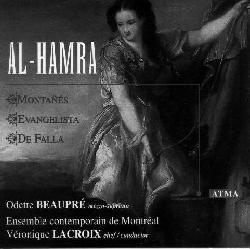 The latest disc from the Ensemble contemporain de
Montréal features Spanish music of the 20th century. The latest disc from the Ensemble contemporain de
Montréal features Spanish music of the 20th century.
The title track "Al-Hamra", commissioned
from José-Manuel Montañés by the ECM, is an instrumental piece in
three sections, the first two richly atmospheric and the last highly
percussive. The outer sections are united by a single descending
melodic theme which undergoes various transformations. The
predominance of the oboe is undoubtedly intended to recall the
middle-eastern shawm. Unfortunately, from the initial melodic
statement, the phrase, as played by this particular instrument,
occasionally lacks musical impetus, marring an otherwise striking
performance.
Mezzo-soprano Odette Beaupré tackles José
Evangelista’s "Ramillete de canciones populares" (Little Bouquet of
Popular Songs) with great character. True to the liner-note
description of being "both devoid of harmony or counterpoint", the
songs achieve their charm through melody and Beaupré’s chatty
interpretation. She finds great humour in the fast songs, but in
truth, they all end up sounding alike: more differentiation would be
an improvement. Beaupré’s warm, hushed tone in "Adiós, meu homiño"
is her most effective reading.
The ECM pulls out the stops in its
rendition of the original version of De Falla’s El Amor
Brujo. As the gypsy
Candelas, Beaupré deploys exciting vocal colours to tell her story
of betrayed love. The ECM provides a multi-textured landscape to
show off her bold work. Particularly passionate is the spoken
"Fisherman’s Romance" supported by a mournful accompaniment,
followed by the surprisingly salon-like "Intermezzo". Though the
absence of text or translations in the liner notes will leave
non-Spanish speakers in the dark, there is much to enjoy in the
spirited music on this disc. Peter Phoa
- Vivaldi, Marcello, Platti:
Concertos Pour Bois
- Bruce Haynes, hautbois baroque
- Frans Brüggen, flûte et direction
musicale
- l’Orchestre du XVIIIe siècle
- Sony SEON SBK 62945 ADD 78’02’’
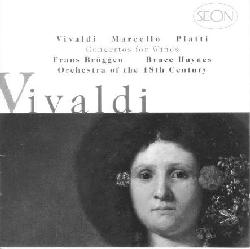 Les six concertos pour flûte traversière
et cordes, opus 10, de Vivaldi, constituent l’essentiel de cette
réédition dans la collection SEON. Brüggen nous en propose une
interprétation qui témoigne d’un souci musicologique certain
(instruments d’époque, etc.). Auréolée d’un Diapason d’or en 1979,
cette version saura plaire aux puristes baroqueux. Elle nous semble
cependant moins vivante que l’interprétation des Solisti Veniti sous
la direction de Claudio Scimone, avec le flûtiste Jean-Pierre
Rampal. En comparaison, les rythmes métronomiques de Brüggen
apparaissent plus académiques que véritablement inspirés. La
différence est particulièrement frappante dans le premier mouvement
des concertos numéros 3 et 5. Les Solisti Veniti et Rampal y font
preuve de finesse et de subtilité, alors que Brüggen se contente
d’un travail certes soigné, mais somme toute assez compassé. C’est
toute la différence entre jouer et faire de la musique. Évidemment,
toutes les formations n’ont pas la chance de bénéficier d’un soliste
de la trempe de Jean-Pierre Rampal. Considerant son prix très
abordable, toutefois, la version de Brüggen peut s’avérer un choix
judicieux pour les budgets serrés. Rodrigue
Audet Les six concertos pour flûte traversière
et cordes, opus 10, de Vivaldi, constituent l’essentiel de cette
réédition dans la collection SEON. Brüggen nous en propose une
interprétation qui témoigne d’un souci musicologique certain
(instruments d’époque, etc.). Auréolée d’un Diapason d’or en 1979,
cette version saura plaire aux puristes baroqueux. Elle nous semble
cependant moins vivante que l’interprétation des Solisti Veniti sous
la direction de Claudio Scimone, avec le flûtiste Jean-Pierre
Rampal. En comparaison, les rythmes métronomiques de Brüggen
apparaissent plus académiques que véritablement inspirés. La
différence est particulièrement frappante dans le premier mouvement
des concertos numéros 3 et 5. Les Solisti Veniti et Rampal y font
preuve de finesse et de subtilité, alors que Brüggen se contente
d’un travail certes soigné, mais somme toute assez compassé. C’est
toute la différence entre jouer et faire de la musique. Évidemment,
toutes les formations n’ont pas la chance de bénéficier d’un soliste
de la trempe de Jean-Pierre Rampal. Considerant son prix très
abordable, toutefois, la version de Brüggen peut s’avérer un choix
judicieux pour les budgets serrés. Rodrigue
Audet
- Puccini Arias
- José Curas, tenor
- Philharmonia Orchestra
- Placido Domingo, conductor
- Erato 0630-18838-2 (Warner)
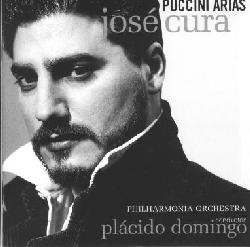 The most surprising aspect of this new
participant in the tenor sweepstakes is that the advance publicity
hasn’t been bigger. When you think of the excessive hoopla
surrounding Roberto Alagna’s arrival a few years ago, you’d expect
that a tenor as good and gusty as 35-year old Argentinean José Curas
would deserve a push. Regardless of how Curas sounds in live
performance, on disc he is the real thing. He has the heft and lilt
of a Puccini and Verdi tenor apparently without having progressed
through the lighter repertoire. Of course, Domingo’s approval of
Curas counts for something, but the sound is its own recommendation.
Detractors may criticize the voice as a bit rough and heavy, and
Curas’s shameless sobbing went out of fashion in the 1950s (well,
maybe not in Argentina). Still, voice lovers will find this an
exciting and promising disc, much more than a mere curiosity.
P.A
. The most surprising aspect of this new
participant in the tenor sweepstakes is that the advance publicity
hasn’t been bigger. When you think of the excessive hoopla
surrounding Roberto Alagna’s arrival a few years ago, you’d expect
that a tenor as good and gusty as 35-year old Argentinean José Curas
would deserve a push. Regardless of how Curas sounds in live
performance, on disc he is the real thing. He has the heft and lilt
of a Puccini and Verdi tenor apparently without having progressed
through the lighter repertoire. Of course, Domingo’s approval of
Curas counts for something, but the sound is its own recommendation.
Detractors may criticize the voice as a bit rough and heavy, and
Curas’s shameless sobbing went out of fashion in the 1950s (well,
maybe not in Argentina). Still, voice lovers will find this an
exciting and promising disc, much more than a mere curiosity.
P.A
.
- Manuel de Falla: El Amor
Brujo & El Retablo de Maese Pedro
- I Cameristi
- Naxos 8.553499
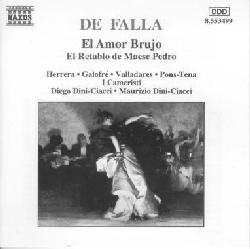 This bargain coupling of de Falla’s two mimodramas
is the perfect preparation for the Montreal Symphony’s upcoming
performances of these two works (see calendar Oct. 7 & 8, Nov.
25 & 26). The superb Italian chamber ensemble performs the
spicy, longer 1915 version of El Amor Brujo with complete
dialogue. The Gypsy girl Candelas is sung with idiomatic gusto by
the excellent Spanish mezzo-soprano Nancy Fabiola Herrera. Though
"The Dance at the End of the Day" may not be as rhythmic as the
Montreal Symphony’s own recording on London, the rest of the
performance is of outstanding purity, authenticity and
sophistication. El Retablo de Maese Pedro is equally rewarding. The recorded sound is perfectly
natural, rich and balanced. Helpful notes and texts in Spanish,
French, English and German complete the package. This is one of
Naxos’s most successful efforts to date. Very highly recommended.
P.A
. This bargain coupling of de Falla’s two mimodramas
is the perfect preparation for the Montreal Symphony’s upcoming
performances of these two works (see calendar Oct. 7 & 8, Nov.
25 & 26). The superb Italian chamber ensemble performs the
spicy, longer 1915 version of El Amor Brujo with complete
dialogue. The Gypsy girl Candelas is sung with idiomatic gusto by
the excellent Spanish mezzo-soprano Nancy Fabiola Herrera. Though
"The Dance at the End of the Day" may not be as rhythmic as the
Montreal Symphony’s own recording on London, the rest of the
performance is of outstanding purity, authenticity and
sophistication. El Retablo de Maese Pedro is equally rewarding. The recorded sound is perfectly
natural, rich and balanced. Helpful notes and texts in Spanish,
French, English and German complete the package. This is one of
Naxos’s most successful efforts to date. Very highly recommended.
P.A
.
- On The Muse’s Isle: Songs
&Sonatas by Henry Purcell
- Daniel Taylor, countertenor
- Da Sonar
- Atma ACD 22133 (SRI)
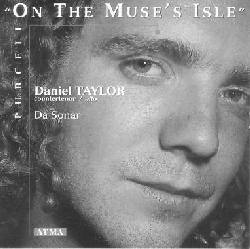 For his first solo disc, 27-year old Canadian
countertenor Daniel Taylor has rightly chosen the Purcell songs and
arias which he has performed locally to great acclaim over the past
few years. Purcell’s lyrics are the solemn, ceremonious, sensitive
voice of Tudor England: no mad scenes or Farinelli-style showpieces
here. These delicate domestic songs include favourite masterpieces
such as "Music for a while" and "Fairest isle" as well as the
dirge-like "Now that the sun has veiled his light". Taylor offers
two versions of "O solitude", one accompanied by the full Da Sonar
ensemble and the other by lute. My favourite piece on this disc is
Blow’s An Ode on the Death of Mr. Henry Purcell because it comes closest
to Daniel’s superb live performances. Those of us who cherish
memories of Daniel’s recent live concerts may miss something of his
warmth and communicative delicacy on this disc, but that is merely
the quibble of a devoted fan. The Da Sonar ensemble, made up of
Montreal’s best baroque instrumentalists, gives flawless
performances of four Purcell sonatas. By any standard, this is one
of the most important Canadian releases of the year, a charming
portrait of Canada’s greatest countertenor, which whets our appetite
for Taylor’s future releases on Atma.
P.A. For his first solo disc, 27-year old Canadian
countertenor Daniel Taylor has rightly chosen the Purcell songs and
arias which he has performed locally to great acclaim over the past
few years. Purcell’s lyrics are the solemn, ceremonious, sensitive
voice of Tudor England: no mad scenes or Farinelli-style showpieces
here. These delicate domestic songs include favourite masterpieces
such as "Music for a while" and "Fairest isle" as well as the
dirge-like "Now that the sun has veiled his light". Taylor offers
two versions of "O solitude", one accompanied by the full Da Sonar
ensemble and the other by lute. My favourite piece on this disc is
Blow’s An Ode on the Death of Mr. Henry Purcell because it comes closest
to Daniel’s superb live performances. Those of us who cherish
memories of Daniel’s recent live concerts may miss something of his
warmth and communicative delicacy on this disc, but that is merely
the quibble of a devoted fan. The Da Sonar ensemble, made up of
Montreal’s best baroque instrumentalists, gives flawless
performances of four Purcell sonatas. By any standard, this is one
of the most important Canadian releases of the year, a charming
portrait of Canada’s greatest countertenor, which whets our appetite
for Taylor’s future releases on Atma.
P.A.
- Beethoven: Piano Concerto No.
2 & No. 5
- Evgeny Kissin, piano
- Philharmonia Orchestra/ James
Levine
- Sony SK 62926
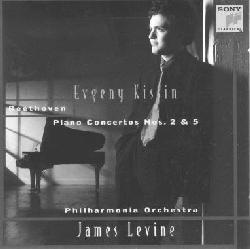 This recording is Russian pianist Evgeny
Kissin’s first recording of Beethoven piano concertos. Kissin and
Levine play Piano Concerto No. 2, Op. 19, almost like chamber music,
while Concerto No. 5, Op. 73, is given a more grandiose symphonic
treatment. Levine conducts Op. 19 like a Mozart overture, sprightly
and cantabile. Kissin’s characteristic light attack and precise
fingering are well suited to this approach, and frankly the whole
concerto is most remarkable for Kissin’s note-perfect execution at
every tempo. The "Emperor" Concerto (No. 5) is given a bigger but by
no means barnstorming treatment. The "quiet before the storm"
transition to the last movement could have been more pastoral.
Anyone expecting Levine’s usual big sound and slow tempi will be
surprised by the Philharmonia’s quasiperiod instruments sound. The
piano is woody-sounding, dry and closely miked. The sonic effect of
strings split left and right then united in ensemble passages (first
movement of Op. 19, second movement of Op. 73) is impressive at
first, then a bit gimmicky. The Philharmonia is competent, but ugly
scraping from a violin in the Rondo of Op. 19 and elsewhere
seriously compromises this recording. In short, a must for Kissin
buffs, but optional for the rest of us. Martin
Kamela This recording is Russian pianist Evgeny
Kissin’s first recording of Beethoven piano concertos. Kissin and
Levine play Piano Concerto No. 2, Op. 19, almost like chamber music,
while Concerto No. 5, Op. 73, is given a more grandiose symphonic
treatment. Levine conducts Op. 19 like a Mozart overture, sprightly
and cantabile. Kissin’s characteristic light attack and precise
fingering are well suited to this approach, and frankly the whole
concerto is most remarkable for Kissin’s note-perfect execution at
every tempo. The "Emperor" Concerto (No. 5) is given a bigger but by
no means barnstorming treatment. The "quiet before the storm"
transition to the last movement could have been more pastoral.
Anyone expecting Levine’s usual big sound and slow tempi will be
surprised by the Philharmonia’s quasiperiod instruments sound. The
piano is woody-sounding, dry and closely miked. The sonic effect of
strings split left and right then united in ensemble passages (first
movement of Op. 19, second movement of Op. 73) is impressive at
first, then a bit gimmicky. The Philharmonia is competent, but ugly
scraping from a violin in the Rondo of Op. 19 and elsewhere
seriously compromises this recording. In short, a must for Kissin
buffs, but optional for the rest of us. Martin
Kamela
|


